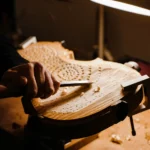Interpreting Sound: The Dialogue Between Musician and Luthier
Back to BlogWhere Craft Meets Interpretation
No violin is complete until it resonates with the soul of its player. While its structure is shaped by the luthier, its voice is ultimately refined through interaction—through feedback, listening, and acoustic intuition. At Amorim Fine Violins, we see sound as a shared language spoken fluently only when luthier and musician are in harmony.
The Language of Tone: Translating Feeling into Craft
Musicians often describe sound in subjective terms—“too tight,” “not breathing,” “lacks depth.” These are not mere impressions but tonal requests waiting to be translated. The luthier, trained to read sonic nuance, interprets these descriptions into concrete adjustments to the soundpost, bridge, or strings.
This process is rarely linear. It requires a patient exchange of trial, error, and sensitivity. Each player has a different conception of tone shaped by their history, instrument, repertoire, and performance space. Our role is to decipher and respond, often with changes measured in tenths of millimeters.
Collaboration, Not Correction
A sound adjustment is not a “fix”—it’s a refinement. The musician is not a client with a complaint but a collaborator in a tonal journey. Whether a soloist preparing for a concerto or a quartet member refining balance, the luthier becomes a tonal partner.
Amorim Fine Violins nurtures long-term relationships with performers who return for seasonal recalibrations or sound evolution. Trust is central. It allows both parties to work beyond mechanics, toward sonic identity.
Adjusting Across Styles and Repertoires
Baroque, Romantic, and contemporary repertoire each demand unique tonal qualities. Baroque specialists may request gut string setups and a lighter soundpost fit. Romantic performers often seek tonal bloom and warmth. Contemporary players prioritize articulation and projection.
Each style requires thoughtful tonal interpretation. We collaborate closely to adjust components accordingly—changing post tension, adjusting bridge feet, selecting strings, or altering tailpiece geometry to serve interpretive goals.
Case Study: Finding the Right Voice for Brahms
A violist preparing Brahms’ sonatas came to us with concerns: the C string felt muted, and upper positions lacked color. After reviewing her playing and listening to rehearsals, we identified subtle asymmetries in the bridge cut and a slightly over-tensioned soundpost. By reshaping the bridge and easing post pressure, the viola gained resonance, especially in lyrical passages. The performer later described the instrument as “finally breathing with me.”
The Silent Work That Supports the Stage
Many of the finest acoustic adjustments remain invisible—yet they underpin every performance. Luthiers rarely take a bow, but our work resonates in every phrase, every shift, every pianissimo. Our goal is not to impose a sound, but to unlock the one already present, waiting to emerge.
A Dialogue That Never Ends
Tone is a living concept. It evolves with the player, the instrument, and the repertoire. That is why the dialogue between luthier and musician is never complete—it deepens. At Amorim Fine Violins, we listen as closely as we carve, adjust, or refine.
We invite musicians to begin a conversation with our team—where the sound you seek becomes the sound you share, shaped together with care, sensitivity, and respect for the music within.









